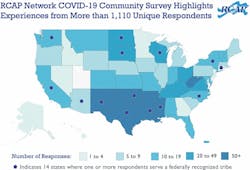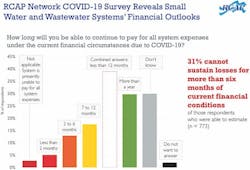The Impact of COVID-19 on Rural & Tribal Water Systems
Ashley Zuelke is senior director of research & communications for RCAP. Kinsey Brown is communications manager for RCAP. Zuelke can be reached at [email protected]. Brown can be reached at [email protected].
undefinedCOVID-19 has impacted communities across the country differently. Rural and tribal water systems across the continental U.S. and its territories are experiencing this crisis in disparate ways. When the Rural Community Assistance Partnership (RCAP) surveyed the nation’s smallest systems in early May 2020, two common themes showed throughout responses: Many small systems are still operating with great financial uncertainty and capacity challenges existing before the pandemic have exacerbated.
For context, the RCAP Network is a national partnership of six nonprofit partners providing opportunity, assistance, and practical guidance to rural communities in all 50 states, U.S. territories, and tribal lands to ensure access to safe drinking water, sanitary wastewater disposal and economic prosperity. On average, this network serves approximately 2,000 communities each year, including more than 3.2 million rural and tribal residents last year.
The RCAP Network surveyed small, rural and tribal water and wastewater systems to understand the financial and managerial impacts of COVID-19. RCAP regional partners reached out to communities they are currently serving and even those previously served.
Overall, the survey received 1,137 unique responses from systems in 49 states and Puerto Rico. 7.5% of those responses represent utilities serving federal recognized tribes. Of the responses, 49 states were represented as well as Puerto Rico. The RCAP Network works on-the-ground in small communities across the country, and technical assistance providers’ close community relationships made this wide survey sample possible.
The average respondent system size was 900 connections, or approximately 2,340 residents. This focus on the smallest communities and systems sets this survey apart, especially since 93.5% of systems in the U.S. serve 3,300 people or fewer.
We should note the results are not necessarily representative of all small systems across the country, but they do paint a broad picture of the impact of the pandemic on small systems and provide paths forward for lawmakers to continue to provide support to those who need it the most.
Financial Challenges & Uncertainty
One of RCAP’s key concerns in its work—and especially considering the impact of the COVID-19 pandemic—is systems’ financial sustainability. Even two months into many stay-at-home or safer-at-home directives, many respondents to the survey said it was too early to discern the financial impact of the COVID-19 crisis on their system. Nearly one-third of respondents said they were not sure how long they would be able to continue paying for system expenses. However, of those who could estimate their financial outlook, more than 31% indicated that they could not cover all system expenses for more than six months of pandemic and current conditions.
COVID-19 has caused or compounded many small systems’ financial hardship. Approximately 43% of all respondents said they experienced or anticipated negative financial impacts because of the pandemic. This increased to 64% when considering only respondents serving federally recognized tribes. Respondents were more likely to indicate negative impact if they had a larger percent of their revenues from commercial or industrial customers, including schools and businesses that have been closed due to the pandemic. RCAP also found that systems in states with stay-at-home or safer-at-home orders had a greater percent of respondents with negative financial impact. This indicates that even if some respondents noted that they had not been impacted by the pandemic, if the pandemic expands to those areas, causing them to invoke public health orders or industrial customers close for a period, greater financial impacts to small water and wastewater systems can be expected.
Some systems volunteered to provide information on how much revenue they are losing. The median monthly revenue loss per respondent system was $4,685. Using this, RCAP estimates, if conditions under COVID-19 continue, small water systems could face between $3.6 and $5.5 billion in revenue losses over a year. These losses are the result of waived fees, suspended shutoffs, nonpayment issues, lower amounts of tax dollars coming in and other challenges. RCAP estimated potential annual revenue loss conservatively using only survey responses from 33 states and Puerto Rico (those areas where there was sufficient data to provide estimates); the impact would likely be much greater if deduced using revenue loss data from all states. This estimate could also rise as systems get more information on their finances, given that more than 40% could not currently estimate their financial impact.
After analyzing this data, RCAP saw many red flags for the future of small systems. One critical issue to pay attention to is number of systems deferring capital improvements in the wake of the crisis. This could lead to compliance, water quality and financial sustainability and management issues down the road, when communities are struggling even more to recover from the pandemic. Another red flag is how many systems need financial assistance for operations and maintenance—including help paying immediate bills, such as electricity—a task for which most grants and loans fail to account. In many cases, federal resources flow by providing grant and loan dollars for infrastructure improvements, not for operations and maintenance costs, meaning this large financial gap systems are taking on will have implications for the overall health and financial wellbeing of these systems if not addressed.
Additional Challenges
Many small systems operate with one full-time employee or less; 43% of respondents said this was their operating norm. Many systems even operate with contract, part-time or volunteer staff. Survey respondents indicated concerns about capacity and the health of these operators in the maintenance of their systems. If the small system only had one operator who knows the in’s and out’s, and they or their family were to contract COVID-19, continued operation would be very difficult.
Respondents also indicated a clear challenge in accessing Personal Protective Equipment (PPE), other sanitary supplies, and chemicals. Nearly 15% requested help from the RCAP Network in complying with state and/or federal regulations, and nearly 18% requested help navigating complex resources and/or policy changes.
How can we Minimize the Impact on Small Systems?
Based on the survey results, RCAP crafted recommendations for policymakers to consider in future COVID-19 relief legislation. Operations and maintenance relief funding and rate loss protection would assist small systems with their financial hardship. Additionally, access to grants and low interest financing through the U.S. Department of Agriculture Rural Development (USDA-RD) and U.S. EPA state revolving funds (SRFs) would keep systems afloat and in compliance. Loan deferrals, low interest rates and loan forgiveness would afford systems better access to available emergency funds.
RCAP is currently involved in proposed legislation which would create an affordable and permanent line of credit at 1% interest with no payments required during the designated emergency period. This proposal, if enacted, would enhance the USDA Rural Utility Service’s existing tools to deploy during the pandemic and during future covered emergencies, allowing impacted small water system to continue to offer essential services.
Policymakers should also consider decreasing the required match in funds for grant programs during emergencies so small systems with little to no revenue are able to access them. Policymakers also need to consider increasing technical assistance and training programs for small systems, ensuring that these communities can build the capacity necessary to maintain and operate their systems now and in the future.
Small systems can also consider steps to take on their own to minimize the impact of COVID-19. RCAP recommends considering regional collaboration, which about 14% of respondents have pursued. Regional collaboration can include any type of partnership between multiple utilities, from informal collaboration (mutual aid agreements, sharing equipment, sharing personnel, etc.) to more formal partnerships (physical integration, managerial integrations, etc.). Some systems are seeing that by sharing staff and expertise at this time—or even by pursuing deeper partnerships—they can mitigate impact in their region. Some states incentivize collaboration, and technical assistance providers like RCAP are helping facilitate partnerships where utilities choose to pursue them.
Systems can also consider seeking technical assistance and training like that from RCAP and others. This assistance cannot only help with financial or managerial circumstances or planning (even reopening), but also can help systems translate federal and state policy changes and their implications.
Attaining certainty in this environment is a daunting and near impossible task. One thing is for certain; During this crisis, more and more communities, as one respondent said, are recognizing that, “Utility workers are essential employees and valuable to the community.”

